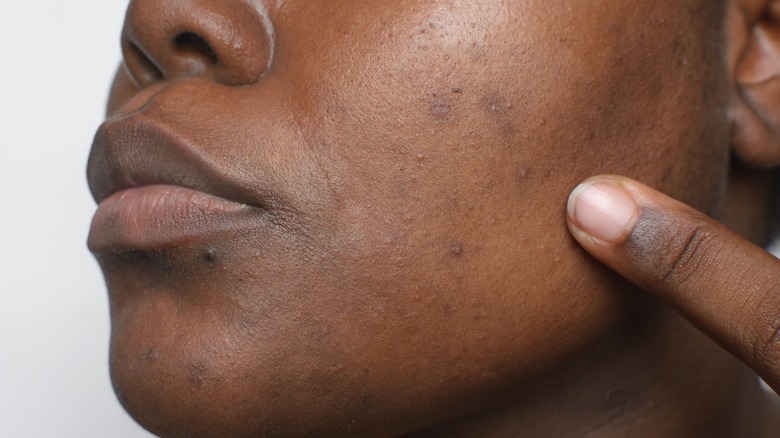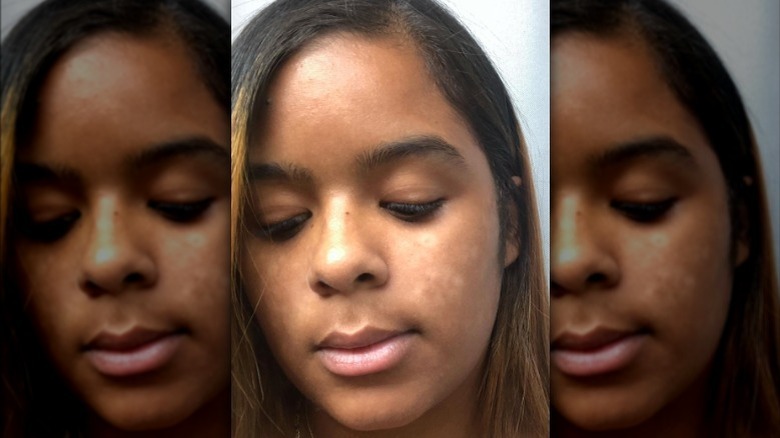What Can Cause Discoloration In Darker Skin Tones?
The one thing we spend a lot of money on other than makeup products is skincare products. We're all trying to achieve smooth, glass-like skin without texture, enlarged pores, or dark spots. However, if you have sensitive skin, you know it's hard to find the right products that won't make matters worse and that will clear up your face as much as possible. Plus, everyone has a different skin type, which helps narrow down which products to use. However, it's still trial and error to determine if they will work for you. Certain products are tailored to fight specific problems — like glycolic acid for dark spots — but knowing why those issues are happening in the first place can help you better understand how to treat them.
Skin discoloration, especially in darker skin tones, is a more intricate condition to treat when trying to get the perfect skin. Even though you can cover up any discoloration with concealer or foundation, there are days when you want to run errands without makeup and without feeling self-conscious. We've all been there, especially when you talk yourself into embracing your skin as it is. However, it can still be challenging to feel 100% confident when you're not the happiest with how your skin looks. Discoloration can happen through medical conditions or naturally in the skin; here are a few things that cause color discoloration in darker skin tones.
Post-inflammatory hyperpigmentation
Post-inflammatory hyperpigmentation is the most common form of discoloration that happens on darker skin tones. According to WebMD, hyperpigmentation occurs when the skin produces too much melanin in one area. Melanin is what gives your skin its color, and it may also be produced as a result of skin injury. For example, you've probably noticed when you get a bug bite after it's gone away, there's a dark spot left behind. This is because the skin cells have been damaged and irritated by the bug bite, so as a result, they make extra melanin. The same thing happens with acne. When you pop a pimple on your cheek or put on spot treatments, the pimple goes away, but the skin cells create a dark spot.
Post-inflammatory hyperpigmentation can take some time to heal if you don't put in any treatments to help with cell turnover. If you want to get rid of the spots quicker, using topical medications can speed up the process. For example, to lighten the spots, use azelaic acid or hydroquinone acid to slow down melanin production. Using retinol and steroids can increase skin cell turnover, so you'll be shedding dead skin cells faster and replacing them with new younger cells. If you enjoy doing face masks, salicylic or glycolic acid chemical peels can remove skin cells with extra melanin. You should always test every treatment you use on a small skin patch to see how you will react to prevent worsening the condition.
Melasma
For women who use birth control or are pregnant, you've probably noticed a few freckle-like dark spots on your face, also known as melasma. When your body is receiving new hormones from birth control or during pregnancy, it'll create dark, discolored spots on your chin, cheeks, forehead, and upper lip, claims the American Academy of Dermatology Association. The dark spots go away after pregnancy or when you stop taking birth control because you're not receiving the extra hormones. However, if the melasma is severe, it may last for years and be difficult to remove with treatment.
Even though melasma usually goes away on its own, there are a few creams you can use to help fade the discoloration. For example, Dermatica has a personalized prescription treatment that can give you an even skin tone. You simply answer a few questions based on your skin type and condition to get the right treatment. On the other hand, you can visit a dermatologist, and they can set up a treatment plan for you in person. In addition, they'll be able to recommend which creams and sunscreens to use for your skin type. If you don't already have sunscreen as part of your skincare routine, it's crucial to start incorporating it to prevent severe discoloration. Reapply the sunscreen every two hours or wear a brimmed hat when you're outside for extra protection.
Tinea versicolor
Post-inflammatory hyperpigmentation and melasma are two of the most common causes of discoloration in darker skin that take longer to treat. Tinea versicolor is another condition that creates dark spots, but is easily treatable. According to Cleveland Clinic, tinea versicolor is a fungal infection that's caused by yeast that has overgrown on the skin. It usually happens when you're in hot or humid weather, and being out in the sun can make the tinea versicolor worse and more noticeable. The spots are light in color for darker skin and usually appear on the arms and back, but they can also appear on the face. They aren't contagious, but they can be mildly itchy.
Even though tinea versicolor can occur anytime in a humid environment, it can go away quickly. Doctors can prescribe oral medication if the tinea versicolor is severe or is on multiple areas of your body. For mild cases, over-the-counter creams, shampoos, or lotions such as Lotrimin AF (clotrimazole), Lamisil AT (terbinafine), or Zinc pyrithione soap, can treat the infection. You'll notice your skin getting better after a few weeks. However, the condition can return in the summer or if you travel to places that have higher temperatures. Therefore, you'll want to keep the remedies by your side if you have an outbreak while you're not home.



